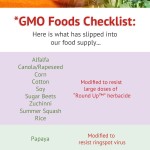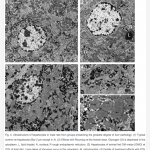
Let's begin to talk about our food, and how it's grown.

Let's begin to talk about our food, and how it's grown.
The purpose of this site isn’t to blame anyone, it’s to open a discussion about what was genetically modified, why it was genetically modified, and how safe is it exactly?

I want the information on here to be refined by 3rd party knowledge.
Under each statement, you will notice a link to discuss the information about it. When you click-through, you will be sent to a forum, specific to that ingredient. This will allow you to contribute and refine any detail of what this site is sharing. I want you to submit ingredient-specific articles for me to consider posting for discussion on the main page! Likewise, if this dialogue is one-sided, if will serve less purpose in bringing truth, then if people are comfortable submitting counter-arguments. Don’t be shy!
These are just the staple foods that I feel are the most important to discuss and potentially avoid. Please open up new topics in the forum for other foods. To go straight to the Forum, CLICK HERE
The bottom line is I don’t want my little girl to eat food that will harm her. I hope you can use this as a resource for yourself and your family.
-
Developed by biotech leader Monsanto Co (MON.N) to tolerate treatments of Monsanto’s Roundup herbicide, “Roundup Ready” alfalfa is preferred by many farmers because it makes killing weeds easier. But opponents, including conventional and organic farmers, say the biotech alfalfa can easily contaminate their crops because alfalfa is pollinated largely by honey bees, making it difficult to isolate GMO fields from non-GMO strains.
Organic dairy farmers who feed their cows alfalfa say the biotech crop can kill their business.
Opponents also say increased use of herbicide is translating to increased weed resistance, and the rise of “super weeds.”
“So what?” you say. “I don’t eat alfalfa.”
But if you eat beef, drink milk, eat cheese or ice cream, or eat any packaged food products that contain dairy, you DO eat alfalfa… as processed by cows. Alfalfa is the backbone of the beef and dairy industry.
So the organic dairy industry is about to change, in a big way: until now, being non-GMO has been a principal part of being organic. But once they let these genes out of the bottle, there’s no going back:
• Alfalfa is an insect-pollinated crop
• There is no way to prevent cross-contamination from fields planted with Monsanto’s GMO alfalfa to other fields.
• These genes will contaminate the rest of America’s alfalfa crops within a few years
• In addition to its key use in dairy farming, alfalfa has also been used as a rotation crop to recharge fields in ecologically-sound agriculture methods.
The Organic Seed Alliance is “very disappointed” with this decision (to say the least)
Alfalfa is grown mostly to make hay fed to dairy cows and horses. More than 20 million acres are grown in the United States; it is the nation’s fourth-largest crop by acreage, behind corn, soybeans and wheat, with a value of about $8 billion. About 1 percent of alfalfa is organic.
In deciding whether to approve the genetically engineered alfalfa, the Agriculture Department was considering restricting areas where the crop could be planted. That, Mr. Vilsack argued, would help prevent litigation, like the lawsuits that have already delayed the approval of genetically altered alfalfa and sugar beets.
As part of his case, Phil gathered samples of conventional and ferrel alfalfa along the roadside around the Treasure Valley and tested them for GMO contamination. 9 out of 10 samples came back as carrying the GMO trait. Contamination is already far spread and is only going to get worse. Alfalfa is the first perennial seed to become GMO and has far reaching consequences. Contamination is VERY likely. In fact it is inevitable.
We are very sad to hear this news. Alfalfa is ruined. You cannot recall the GMO gene in any crop so genetic pollution is here to stay. This will effect not only alfalfa, but organic milk and other beef products. There could be countless alfalfa and dairy producers who are totally unaware that their alfalfa could already contaminated. We could be consuming certified organic dairy also not knowing that it could be contaminated.
In addition, Phil has expressed another concern. When GMO alfalfa is sprayed with Roundup, it is harvested much sooner then other GMO crops that get sprayed with Roundup. This means that more than likely, Roundup is being transferred into our milk supply. GMO Free Idaho and Phil have discussed teaming up in the future to conduct testing of milk in which the alfalfa was sprayed with Roundup to check for herbicide contamination. Phil is certain we will find unacceptable amounts of Roundup in our milk supply.
*Sourced from gmofreeidaho.com
Genetically modified crops are commonplace in fields across the United States, but a new study suggests that some plants have spread into the wild. A survey of North Dakota has turned up hundreds of genetically modified canola plants growing along roads across the state.
The results, presented Friday at the annual meeting of the Ecological Society of America in Pittsburgh, show that the vast majority of feral canola plants in the state contain artificial genes that make them resistant to herbicides. Researchers also found two plants that contained traits from multiple genetically modified varieties, suggesting that genetically modified plants are breeding in the wild.
“What we’ve demonstrated in this study is a large-scale escape of a genetically modified crop in the United States,” says Cindy Sagers, an ecologist at the University of Arkansas, who led the study.
Canola modified to resist either the herbicide glufosinate (brand name Liberty) or glyphosate (brand name Roundup) has been available in the U.S. since 1989—and unregulated since 1998 and 1999, respectively for the two herbicides. “These results are not new for Canadian researchers and to be expected if two types of transgenic herbicide-resistant canola are commercially grown,” says Suzanne Warwick of Agriculture and Agri-Food Canada, a government agency.

What? GMO sweet corn is genetically engineered to be herbicide resistant (Roundup Ready) and to produce its own insecticide (Bt Toxin). Like all GMOs, genetically modified sweet corn has not been thoroughly tested to ensure that it is safe for consumption.
Who? While GMO sweet corn has been produced in the past by Syngenta, this is the first attempt by a biotech company to corner the sweet corn market.
Where? GMO sweet corn can be found in the produce aisle of your local food store and at farmers’ markets and farmstands. It can also be found in processed foods that contain sweet corn.
Cotton has been genetically modified for resistance to glyphosate (marketed as Roundup in North America) a broad-spectrum herbicide sold by Monsanto which also sells some of the Bt cotton seeds to farmers. There are also a number of other cotton seed companies selling GE cotton around the world. About 62% of the GM cotton grown from 1996 to 2011 was insect resistant, 24% stacked product and 14% herbicide resistant.
Cotton has gossypol, a toxin that makes it inedible. However, scientists have silenced the gene that produces the toxin, making it a potential food crop.
Starting a decade ago, 90% of the country’s cotton growers have adopted the GM cotton.
On January 9 an internal advisory, a copy of which is held by the Hindustan Times, was sent out to cotton growing states by the Minister of Agriculture.
The note presents a grim scenario: “Cotton farmers are in a deep crisis since shifting to Bt cotton. The spate of farmer suicides in 2011-12 has been particularly severe among Bt cotton farmers.”
It seems that the success of the Bt cotton lasted only 5 years. Since then, cotton yields have been gradually falling and pest attacks increasing. The GM crop was genetically altered to kill cotton-eating pests. However, for farmers, the rising costs in the form of necessary pesticides have not matched the returns received. This has pushed many farmers to the edge financially and otherwise. In other words the genetically modified crop is no more profitable than it used to be.
In 1998, the first GMO Papaya was commercially released into Hawaii’s growing environment. Dr. Dennis Gonsalves and Dr. Richard Manshardt created this papaya ringspot virus (PRSV) resistant GMO fruit and were experimenting with its release in PRSV ridden Puna, the main papaya growing area of Hawaii. While the GMO Papaya is resistant to papaya ringspot virus, it brought many more problems than it solved. The GMO Papaya has closed lucrative export and organic markets and always has a low price point. This technology has come with too many strings attached and Hawaii has lost almost half of its papaya farmers.
Another unintended problem is GMO contamination. In 2003, GMO Free Hawaii became very concerned with the gene flow of the GMO Papaya. First, we used the GUS gene test to see how much contamination was on our farms and in our community. After consistently finding 30-50% of the seeds and leaves we tested having some kind of air or seed contamination, we wanted to know more. We put out calls for independent, peer-reviewed academic studies to examine the levels of this GMO Papaya contamination, to no avail. In 2004, GMO Free Hawaii designed a study to look at the extent of GMO contamination around the state.
The University of Hawaii and Pacific Research Basin have responded inadequately to the news of our test results. Their insufficient attempts at follow- up studies have included testing too few UH seeds to provide statistically significant results, a pollen study by an undergraduate on the island with the least contamination and a promise of a study by Carol Gonsalves (Dr. Gonsalves’ wife) that has not materialized. Promises of GUS testing for papayas being available to farmers and gardeners through the Cooperative Extension service have not materialized either. Finally, no attempts at GMO Papaya clean-up by the responsible institutions have been made, to date.
Finally, this pilot study shows more GMO Papaya contamination than anyone expected. Our recommendations include:
1. Governments around the globe should not introduce the GMO Papaya into any new growing regions. Even as a field trial, GMO Papaya cannot be contained.
2. Considering the adverse consequences of the GMO Papaya, the Hawaii Department of Agriculture should not commercially release any more GMO crops in Hawaii.
3. The University of Hawaii should clean up the GMO contamination in their non-GMO papaya seeds before selling any more.
4. GMO Papaya testing should be offered to Hawaii Island farmers and gardeners either free of charge or at a nominal cost by the University of Hawaii and PBARC/USDA (Pacific Basin Agriculture Research Center/United States Department of Agriculture), so they can rogue out GMO Papaya contamination.
5. Education about using traditional and alternative methods of Papaya ringspot virus management including introducing PRSV tolerant3 varieties should be actively offered to farmers by the University of Hawaii and PBARC/USDA .
6. An independent peer-reviewed study examining the full extent of the GMO Papaya contamination in Hawaii should be authorized by the Hawaii Department of Agriculture.
7. An independent peer- reviewed study examining the possible health effects on humans of the GMO Papaya consumption should be authorized by the Hawaii Department of Agriculture.
Human blood protein
Human serum albumin (HSA) is a blood protein in human plasma. It is used in treatment such as severe burns, liver cirrhosis, and hemorrhagic shock. More importantly, it is used in blood donations and thus is in short supply around the world. In China, the scientists modified brown rice as a cost effective way to produce HSA protein. The Chinese scientists put recombinant HSA protein promoters into 25 rice plants using Agrobacterium. Out of the 25 plants, nine of them breed (brown rice plants), and contained the HSA protein. They confirmed that the genetically modified brown rice had the same amino acid sequence as human serum albumin. They called this protein Oryza sativa recombinant HSA. The modified rice were transparent compared to regular rice. Additionally, they tested this protein on the rats with liver disease. The rats showed improved liver function.
Human health
Some people have concerns that GMOs may be created with genes that affect human biology in such a way that the effectiveness of antibiotics is reduced, or that additional allergens may be created in GMO foods.[17] There is evidence that GMO foods have great impact on human life
Contamination
Genetically modified plants may potentially cross-pollinate with non modified plants, which could possibly lead to the spread of herbicide-resistance or additional levels of pest resistance to weeds or wild plants. Thus, genetically modified plants might compete with non modified plants and overtake in agriculture, forests, and the wild. In effect, people will need to have stronger herbicide sprays to get rid of them.
Economic concerns
Making genetically modified rice takes time, research, and money. If an approved GM rice is introduced to the market, only the big agricultural industries will be able to afford this. According to some consumer advocates, the new plant varieties will raise the price of seeds. The small farmers and third world countries will suffer from such change financially. Developing countries will have to depend on richer countries like U.S. to fund these crops.
After the mistaken release, the U.S. Food and Drug Administration ruled that the genetically modified rice is safe to eat, but that didn’t bring back the European market.
“I don’t think we’re ever going to be made whole, but you get what you can,” said farmer Jonathan Hillman of Stuttgart, Ark.
Hillman said the effect was immediate when word came out in 2006 about the genetically modified rice.
“We didn’t do anything wrong. Bayer lets this happen and it affects us more than it does Bayer,” Hillman said.
Bayer was accused of knowing there was contamination, but the company has not admitted fault and stated when announcing the settlement that “Bayer CropScience believes it acted responsibly in the handling of its biotech rice.”
The settlement is open to affected growers even if they haven’t filed lawsuits.
Arkansas is first in rice production, followed by California and then Louisiana.
As for soybeans, approximately 95% of the US crop is GM, and approximately 85% of the world’s soybean crop is processed into soybean meal and vegetable oil. The bulk of the soybean crop is grown for oil production, with the high-protein defatted and “toasted” soy meal used as livestock feed and dog food. 98% of the U.S. soybean crop is used for livestock feed. A smaller percentage of soybeans are used directly for human consumption.
*Sourced from www.genengnews.com
The United States imports 10% of its sugar from other countries, while the remaining 90% is extracted from domestically grown sugar beet and sugarcane. Of the domestically grown sugar crops, half of the extracted sugar is derived from sugar beet, and the other half is from sugarcane.
After deregulation in 2005, glyphosate-resistant sugar beet was extensively adopted in the United States. 95% of sugar beet acres in the US were planted with glyphosate-resistant seed in 2011.Sugar beets that are herbicide-tolerant have been approved in Australia, Canada, Colombia, EU, Japan, Korea, Mexico, New Zealand, Philippines, Russian Federation, Singapore, and USA.
The food products of sugar beets are refined sugar and molasses. Pulp remaining from the refining process is used as animal feed. The sugar produced from GM sugarbeets is highly refined and contains no DNA or protein—it is just sucrose, the same as sugar produced from non-GM sugarbeets.
Genetically engineered sugar beets have been grown commercially in the US since 2008. That year about half of the crop was genetically engineered. The industry projected that about 90 percent of sugar beets would be genetically engineered by 2009. So, with 50% of the sugar supply from sugar beets, most of us have probably already been exposed to genetically engineered sugar.
GE sugar beets are dangerous for people, pollinators and the environment. The risks of GE sugar beets are enhanced by the fact that they contaminate non-GMO crops. Just to name one example, GE sugar beet specklings were inexplicably found in potting soil mix sold to gardeners at a landscape supply business.
GE sugar beet production significantly reduces the number of bees and butterflies in beet fields.
GE sugar beets are designed to withstand strong doses of Monsanto’s controversial broad spectrum Roundup herbicide. Studies indicate farmers planting Roundup Ready crops spray large amounts of the herbicide, contaminating both soil and water. Farmers planting GE sugar beets are told they may be able to apply the herbicide up to five times per year.
Roundup, also known as glyphosate, is linked to cancer. Monsanto has successfully lobbied to increase human exposure to its carcinogen. When it first commercialized its Roundup Ready crops, Monsanto applied for and was granted an increase in the level of herbicide residue allowed to remain on the crop.